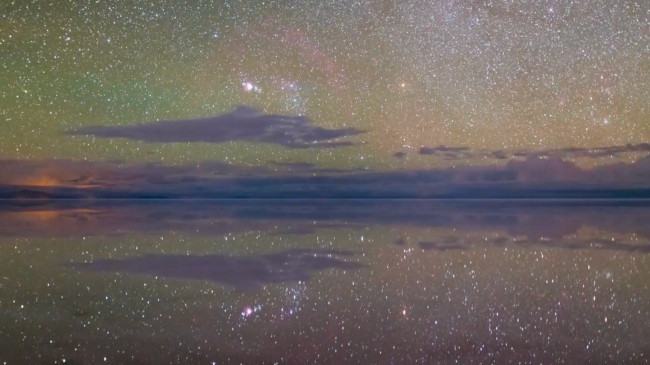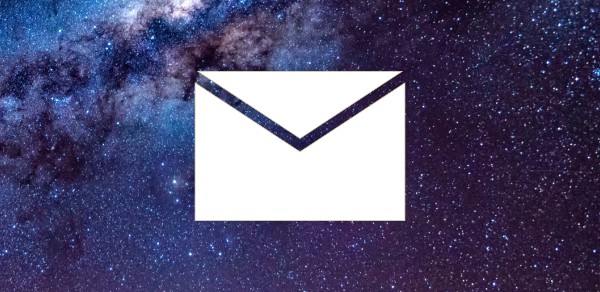This page describes a video Constellations from the World
Video caption:
Third place in the 2022 IAU OAE Astrophotography Contest, category Time lapses of celestial patterns.
This video tries to cover a huge variety of phenomena in the night sky from different locations — Iceland and China — and is designed like a theatre play, starring mother nature herself.
It starts with a blue twilight sky that dims and unveils the starry night sky on the stage with terrestrial clouds on a beautiful landscape. The impressive parts of the southern Milky Way between Scorpius and Crux, with the pointer stars Alpha and Beta Centaurus, are shown passing by majestically. The terrestrial clouds blur the stars and allow us to recognise their colours even more clearly.
The first act presents the starry sky in human culture. One scene shows the Pleiades rising over the top of a hill, while a human moves hastily with a flashlight below. At the very moment that the Pleiades rises behind the hill, the beam of the flashlight hits the camera. There is some humour in this remarkable scene referencing the human relationship to the rise of the Pleiades in cultural history.
The next scene shows The Big Dipper, Ursa Major, as a typical northern constellation, with an arch of aurora below it. The aurora evolves and moves but does not change much fundamentally. In northern human cultures, aurorae were often interpreted as the ghosts of ancestors, but this play does not spend any time on human beliefs, instead moving the view southwards in the subsequent scenes. First we see some stars rising shortly before sunrise. The lightcone of Zodiacal light appears in Gemini/Taurus and the horizon gets brighter. In the next scene, at about 1 minute and 13 seconds, we see Orion setting over water, so that the water surface mirrors the celestial scene. Some clouds crossing the image prove that the videos were really taken on our beautiful planet, and, since Orion’s shoulder and foot are seen to set almost simultaneously, this sequence must have been captured almost at the equator. In this area, the bright stars of Orion look like a huge butterfly, with Orion’s Belt forming the body, and the quadrilateral of four bright stars interpreted as the wings.
As in a real theatre, we now see a curtain before the next act of the heavenly play, an aurora curtain. The next act presents several bright stars in original scenes: the Chinese asterisms of The Tail (of the Azure Dragon), the Winnowing Basket and the Southern Dipper, which are seen in the modern constellations Scorpius and Sagittarius. The striking shape of Corona Borealis that has been recognised as an asterism in many cultures all over the globe, is also shown, as are some planets, the stars Vega and Deneb with adjacent areas, Altair, the Milky Way, and the characteristic W shape of Cassiopeia that has also been an asterism for many cultures on Earth.
The outro presents two more scenes with a smooth and silent night sky.
Scroll to captions in other languages
Video credit:
Stephanie Ye Ziyi/IAU OAE
DOI: 10.5281/zenodo.7425668
Related glossary terms:
Big Dipper
, Constellation
, Milky Way
, Orion
Categories:
Milky Way and Interstellar Medium
, Naked Eye Astronomy
Video license: Creative Commons Attribution 4.0 International (CC BY 4.0) Creative Commons Attribution 4.0 International (CC BY 4.0) icons
The media file captions presented on the OAE website were written, translated and reviewed by a collective effort from the OAE, the OAE Centers and Nodes, the OAE National Astronomy Education Coordinators (NAECs) and other volunteers. You can find a full list of credits for our translation project here. All media file captions are released under a Creative Commons CC BY-4.0 license and should be credited to "IAU OAE". The media files themselves may have different licenses (see above) and should be credited as listed above under "credit".
Captions in Different Languages:
Video caption: Dritter Platz beim IAU OAE Astrofoto-Wettbewerb 2022, Kategorie Zeitraffer von Himmelsmustern.
Dieses Video versucht, eine Vielzahl von Phänomenen des Nachthimmels an verschiedenen Orten - Island und China - zu zeigen, und ist wie ein Theaterstück gestaltet, in dem Mutter Natur selbst die Hauptrolle spielt.
Es beginnt mit einem blauen Dämmerungshimmel, der sich verdunkelt und den sternenklaren Nachthimmel auf der Bühne zusammen mit irdischen Wolken über einer wunderschönen Landschaft enthüllt. Die beeindruckenden Teile der südlichen Milchstraße zwischen Scorpius und Crux, mit den Zeigersternen alpha und beta Centauri, ziehen majestätisch vorbei. Die irdischen Wolken verwischen die Sterne und lassen ihre Farben noch deutlicher erkennen.
Der erste Akt zeigt den Sternhimmel in der menschlichen Kultur. In einer Szene sieht man die Plejaden über einem Hügel aufgehen, während ein Mensch mit einer Taschenlampe eilig nach unten läuft. Genau in dem Moment, in dem die Plejaden hinter dem Hügel aufgehen, trifft der Strahl der Taschenlampe die Kamera. Diese bemerkenswerte Szene hat einen gewissen Humor und verweist auf die kulturgeschichtliche Beziehung der Menschen zum Aufgang der Plejaden.
Die nächste Szene zeigt den Großen Wagen (lat. Ursa Major) als typisches nördliches Sternbild mit einem Polarlichtbogen darunter. Die Aurora entwickelt sich und bewegt sich, ändert sich aber nicht grundlegend. In den nördlichen Kulturen der Menschen wurden Polarlichter oft als Geister der Vorfahren gedeutet, aber dieses Stück geht nicht auf den Glauben der Menschen ein, sondern verlagert den Blick in den folgenden Szenen nach Süden. Zunächst sehen wir einige Sterne, die kurz vor Sonnenaufgang aufgehen. Der Lichtkegel des Zodiakallichts erscheint in den Sternbildern Zwillinge und Stier und der Horizont wird heller. In der nächsten Szene, bei etwa 1 Minute und 13 Sekunden, sehen wir den Orion über dem Wasser untergehen, so dass die Wasseroberfläche die Himmelsszene spiegelt. Einige Wolken, die das Bild durchkreuzen, beweisen, dass die Videos tatsächlich auf unserem schönen Planeten aufgenommen wurden, und da Orions Schulter und Fuß fast gleichzeitig untergehen, muss diese Sequenz in der Nähe des Äquators aufgenommen worden sein. Dort sehen die hellen Sterne des Orion wie ein riesiger Schmetterling aus, wobei der Gürtel des Orion den Körper bildet und das Viereck aus vier hellen Sternen als Flügel interpretiert wird.
Wie in einem richtigen Theater sehen wir nun einen Vorhang vor dem nächsten Akt des himmlischen Schauspiels: einen Polarlicht-Vorhang. Der nächste Akt zeigt mehrere helle Sterne am Original-Schauplatz: die chinesischen Sterngruppen des Schwanzes (des Blauen Drachens), des Getreidekorbs und der Südlichen Schöpfkelle, die in den modernen Sternbildern Skorpion und Schütze zu sehen sind. Die auffällige Form der Corona Borealis, die in vielen Kulturen auf der ganzen Welt als Sternbild anerkannt ist, wird ebenfalls gezeigt, ebenso wie einige Planeten, die Sterne Wega und Deneb mit angrenzenden Bereichen, Altair, die Milchstraße und die charakteristische W-Form der Kassiopeia, die für viele Kulturen auf der Erde ebenfalls ein Sternbild ist.
Das Outro zeigt zwei weitere Szenen mit einem ruhigen und stillen Nachthimmel.
Video credit: Stephanie Ye Ziyi/IAU OAE
Related glossary terms: Großer Wagen , Milchstraße , Orion , Sternbild Caption translation status: Not yet approved by a reviewer
Caption translators: Carolin Liefke
Video caption: Terzo posto al concorso di astrofotografia IAU OAE 2022, categoria Time lapses of celestial patterns.
Questo video copre un'enorme varietà di fenomeni del cielo notturno da diverse località - Islanda e Cina - ed è concepito come una rappresentazione teatrale, con protagonista Madre Natura stessa.
Inizia con un cielo blu crepuscolare che si oscura e svela sul palcoscenico la notte stellata con qualche nuvola su un bellissimo paesaggio. Le impressionanti parti della Via Lattea meridionale tra Scorpius e Crux, con le stelle Alpha e Beta Centaurus, si vedono passare maestosamente. Le nuvole offuscano le stelle e ci permettono di riconoscere i loro colori ancora più chiaramente.
Il primo atto presenta il cielo stellato nella cultura umana. Una scena mostra le Pleiadi che sorgono sulla cima di una collina, mentre un uomo si muove con una torcia elettrica in basso. Nel momento stesso in cui le Pleiadi sorgono dietro la collina, il raggio della torcia colpisce la telecamera. In questa straordinaria scena c'è un certo umorismo che fa riferimento al rapporto dell'uomo con il sorgere delle Pleiadi nella storia culturale.
La scena successiva mostra il Grande Carro, l'Orsa Maggiore, come una tipica costellazione boreale, con un arco di aurora sotto di essa. L'aurora si evolve e si muove, ma non cambia in modo sostanziale. Nelle culture umane settentrionali, le aurore erano spesso interpretate come i fantasmi degli antenati, ma questo spettacolo non dedica tempo alle credenze umane, spostando invece lo sguardo verso sud nelle scene successive. Per prima cosa vediamo sorgere alcune stelle poco prima dell'alba. Il cono di luce zodiacale appare nei Gemelli/Toro e l'orizzonte diventa più luminoso. Nella scena successiva, a circa 1 minuto e 13 secondi, vediamo Orione tramontare sull'acqua, che fa da specchio alla scena celeste. Alcune nuvole che attraversano l'immagine dimostrano che i video sono stati girati davvero sul nostro bel pianeta e, dal momento che la spalla e il piede di Orione si vedono tramontare quasi contemporaneamente, questa sequenza deve essere stata catturata quasi all'equatore. In quest'area, le stelle luminose di Orione sembrano un'enorme farfalla, con la Cintura di Orione a formare il corpo e il quadrilatero di quattro stelle luminose interpretato come le ali.
Come in un vero teatro, un sipario di aurora introduce il prossimo atto. Ecco quindi diverse stelle luminose in scene originali: gli asterismi cinesi della Coda (del Drago Azzurro), del Cestello della Mietitura e del Southern Dipper, che si vedono nelle moderne costellazioni dello Scorpione e del Sagittario. Ma anche la suggestiva forma della Corona Boreale, riconosciuta come asterismo da molte culture in tutto il mondo, alcuni pianeti, le stelle Vega e Deneb con le aree adiacenti, Altair, la Via Lattea e la caratteristica forma a W di Cassiopea, anch'essa asterismo per molte culture sulla Terra.
Infine nella conclusione, altre due scene con un silenzioso cielo notturno
Video credit: Stephanie Ye Ziyi/IAU OAE
Related glossary terms: Costellazione , Grande Carro , Orione , Via Lattea Caption translation status: Approved by a reviewer
Caption translators: Valentina La Parola
Caption reviewers: Rodolfo Canestrari









